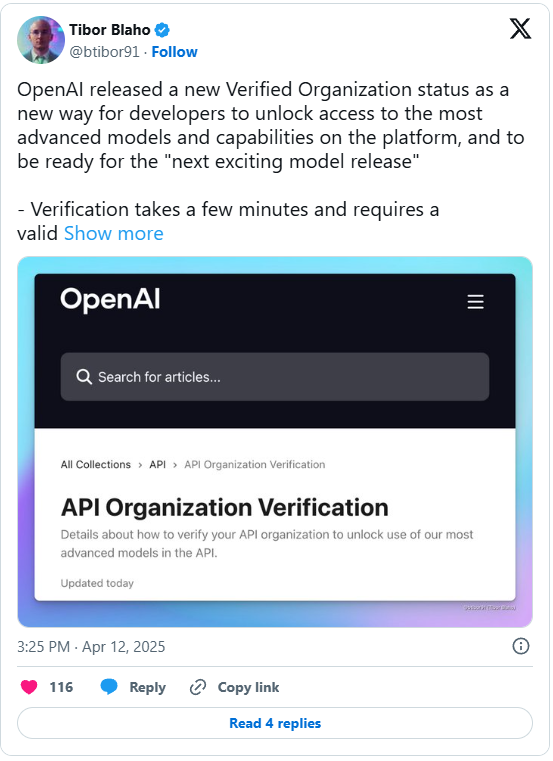As artificial intelligence (AI) continues to evolve, OpenAI is implementing new measures to ensure secure and responsible access to its cutting-edge technologies. According to a support page released by the company last week, OpenAI is introducing an identity verification process for organizations wishing to access certain future AI models. This initiative aims to enhance security and reduce the risk of misuse while continuing to provide advanced tools to a broader developer community.
The new verification process, referred to as "Verified Organization," is designed to allow developers to unlock some of OpenAI's most advanced models and features. To complete the verification, organizations must provide government-issued identification from a country or region where OpenAI’s API is supported. Additionally, the verification process is limited, with each ID being able to validate one organization every 90 days. Not all organizations may be eligible for verification, further ensuring that only those meeting specific criteria can access these high-level resources.
OpenAI emphasizes that this measure is part of their commitment to balancing accessibility with safety. They acknowledge that while most developers follow guidelines, a minority have used OpenAI's tools for harmful or unauthorized purposes. The verification step is intended to reduce such misuse while maintaining open access to AI advancements for legitimate users.

The introduction of identity verification comes as OpenAI faces increasing challenges surrounding the security and ethical use of its products. With AI becoming more powerful and complex, safeguarding against malicious activities is more critical than ever. OpenAI has previously published reports detailing efforts to monitor and minimize the malicious use of its models. These measures include tracking potential abuses, such as those allegedly originating from groups in North Korea.
Additionally, this initiative may also be aimed at preventing intellectual property theft. Earlier this year, Bloomberg reported that OpenAI was investigating whether an organization linked to the Chinese AI lab DeepSeek was using the company’s API to illegally harvest large volumes of data—potentially to train their own models in violation of OpenAI’s terms of service. This is part of OpenAI's broader efforts to protect its intellectual property and ensure the responsible distribution of AI technologies.
While OpenAI has made its services available to a wide range of users globally, the new verification process signals a shift toward more rigorous oversight as AI tools become increasingly integrated into diverse industries. This move reflects a growing trend in the tech industry where platforms are becoming more conscious of security concerns and the potential risks associated with their technologies.
OpenAI's decision to implement these safeguards is not just a response to past incidents but a proactive step toward ensuring that AI remains a force for good. By validating the identities of those who gain access to its most advanced models, OpenAI is striving to strike a balance between innovation and responsible use.
As OpenAI continues to lead the charge in AI development, the company’s new identity verification process is a key measure to safeguard its technologies and prevent misuse. This move aligns with the growing need for accountability in AI usage and is likely to shape how other tech companies approach security in the future. For developers and organizations, this will mean increased scrutiny but also a safer, more trusted environment in which to build and deploy advanced AI solutions.
For those interested in accessing OpenAI's upcoming models, it's important to stay updated on the latest verification guidelines and ensure that your organization meets the eligibility requirements.